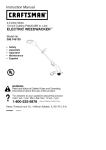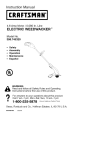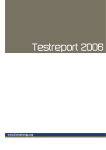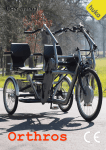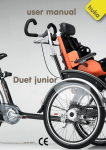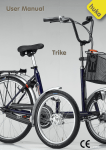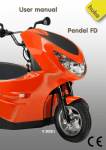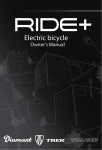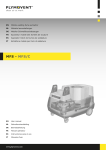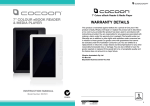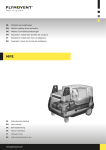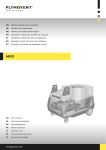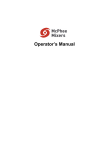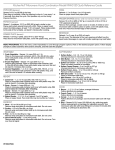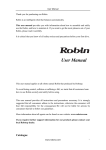Download User Manual
Transcript
User Manual Country 1 V 2010-1 1. CONTENTS Chapter 1. 2. 3. 4. 5. 6. 7. 8. Contents Manufacturer details Introduction Declaration of Conditions of Intended use Safety Product description 9. Set-up 10. Use 11. Maintenance page Conformity warranty 8.1 8.2 8.3 8.4 8.5 8.6 8.7 8.8 8.9 8.10 8.11 8.12 8.13 8.14 8.15 8.16 8.17 9.1 9.2 9.3 9.4 9.5 9.6 10.1 10.2 10.3 10.4 10.5 10.6 10.7 10.8 10.9 11.1 11.2 The frame Mudguards Drive mechanism Wheels and tyres Spokes Brakes Parking brake The chain guard Crankshaft, crankset and pedals The chain Gears Saddle Handlebars Lights Luggage carrier Electric motor Accessories The saddle height The saddle depth The saddle angle Height of handlebars The wheels Tyre pressure Using for the first time Mounting Cycling Steering Changing gears Brakes Cycling with motor Motor with 3 gears Motor with kick-start User maintenance Huka dealer maintenance 12. Disposing of product 13. Selling the bike 14. Technical details 2. MANUFACTURER DETAILS City 24 2 3 4 5 6 7 8 9 9 9 10 10 10 11 11 11 12 12 12 13 13 13 14 15 16 17 17 18 18 18 19 19 19 19 20 20 21 21 22 24 30 30 31 32 32 2 Huka B.V. Munsterstraat 13 7575 ED Oldenzaal The Netherlands tel. +31 (0541) 572 472 fax. +31 (0)541 520 415 mail: [email protected] web: www.huka.nl Huka BV Huka BV is a Dutch company that manufactures physical aids for disabled persons. Please contact your supplier if you have any questions about our products and their use. Changes Huka BV reserves the right to alter the product described in this manual. This frees us from any liability whatsoever. 3 3. INTRODUCTION Cycling is intended as an enjoyable activity. The fact that millions of people cycle their bikes every day with pleasure appears to bear out this fact. The bicycle is more than just a means of transport. It signifies freedom and a sense of adventure. Bicycles are kind to our environment; they give us that “green feeling”. However, not everyone is able to enjoy the pleasures of the common two-wheeler. Huka has added a series of three-wheelers to its range so that everyone can experience all the pleasurable aspects of cycling. Things like ergonomics, measurements, quality and look have played a very important part in their design. General Information Your Huka three-wheeler is a quality product. Each and every component of your Huka three-wheeler has been rigorously tested. The frame and its added features are all made to the highest standards. This guarantees you both an excellent product and carefree enjoyment. When you receive delivery of your Huka three-wheeler, all of the parts will already have been fine-tuned according to your specifications. However modern it might be though, even a Huka three-wheeler is not maintenance-free. Sometimes there will be things that demand your attention. This manual contains instructions on the kind of maintenance you can carry out yourself and information about what your Huka dealer can do. Being able to carry out some of the maintenance yourself only adds to your level of enjoyment! Pay special attention to bold texts written in italics and to wherever you see this symbol. The texts in the green bars are supplementary information and demand extra attention. Make sure you read these carefully. 4 4. DECLARATION OF CONFORMITY Guidelines for medical aids 93/42/EEG Declaration of Conformity for Class 1 medical aid Name of manufacturer: Huka B.V. Address of manufacturer: Munsterstraat 13, 7575 ED Oldenzaal, The Netherlands Product: Three-wheeler Type/name: Country I, the undersigned, do hereby confirm that the above-mentioned medical aid meets with all the essential requirements as outlined in appendix 1 of the guidelines for medical aids 93/42/EEG. The product carries the CE seal of approval in accordance with the abovementioned guidelines. Date: 01-03-2009 Name: M. P. Coehoorn, Managing Director Huka B.V. Signature: 5 5. WARRANTY Huka BV provides a two-year warranty for the three-wheeler. This warranty will be administered by your dealer. The warranty does not apply to any damage to or faults in the three-wheeler arising from improper or indiscriminate use. This will be assessed by Huka BV or by a representative appointed by Huka BV. NB: This warranty does not extend to parts that are subject to general wear and tear, such as chain, brakes and tyres. Should you notice a defect, please contact your supplier immediately. They will deal with your enquiry and, if necessary, contact Huka BV. When submitting a claim under the warranty, it is of utmost importance that you provide us with the serial number. This number correlates to the date of delivery and time of production, as well as all parts. : Datum/Date/Datum : : SN Type/Type/Typ 2004-06 406012 Max gewicht/Max weight/Max Gewicht: Huka BV KG Postbus 194, 7570 AD Oldenzaal The Netherlands, Tel: +31 (0) 541 572472 • lees de gebruiksaanwijzing / read the manual / Bitte Bedienungsanleitung lesen Example of serial number sticker This serial number sticker can be found on the bottom of the rear axle. In the case of damage or a defect please contact your supplier and provide them with the serial number 6 6. INTENDED USE General guidelines The Huka three-wheeler has been specially designed for people with a physical and/or mental disability. Cyclists who have developed a fear of falling as a result of old age find the Huka three-wheeler to be an excellent alternative when they want to be able to continue cycling carefree and comfortably. The Huka three-wheelers are also used by people who suffer from neuromuscular disorders (such as cerebral palsy, muscular dystrophy and spasms). This also applies to problems with coordination of movement, balance and limited natural body movement. Area of intended use The three-wheeler has been designed for use on standard public roads and bicycle paths. These are usually paved, level and solid. The three-wheeler conforms to all regulations in relation to use on public roads. Use of the three-wheeler as a racer or cross-country bicycle is not included in the above. The manufacturer is not liable when the three-wheeler is used in areas other than those for which it is designed. 7 7. SAFETY Make sure that when you go cycling you always do so safely. We recommend that you pay attention to the following before you go cycling: - Make sure your bike is in perfect condition before using it. - Check the pressure and the condition of the tyres. - Check the brakes. - Check your lights. - Check that the saddle is securely fastened. - Check that the handlebars aresecurely fastened. - Check that there is no play in the wheels. - Check that the battery (if applicable) is charged. - If you are taking luggage with you, make sure it is securely attached and cannot fall off while you are cycling. - Always cycle on level and solid ground. - Avoid potholes, high ramps and puddles. - Do not bump against the kerb and do not cycle too fast off the kerb. - Reduce your speed when cycling on wet and slippy surfaces. - Reduce speed when cycling down hills or off exits. - Use the parking brake when mounting/dismounting. - Always lock your bike when not in use. Use of bike by children: - Never allow small children use the bike on public roads. - We recommend that children wear a reflective vest when cycling. - Attach a reflective flag to children’s bicycles. - Children should wear a safety helmet when cycling. Be safe when cycling! 8 8. PRODUCT DESCRIPTION Components 8.1 The frame The Huka three-wheelers are made of high-quality materials. The frame consists of a metal tube construction with aluminium and stainless steel parts. Most of the metals used are electrolytically galvanized and provided with an impact resistant coating. Together, the construction and finishing guarantee many years of enjoyment. 8.2 Mudguards The mudguards are made of impact resistant plastic and are fully coated. They prevent water from splashing up onto one’s clothes. 8.3 Drive mechanism (optional outside NL) The three-wheeler is equipped with its own specially designed drive mechanism for the rear wheels. This mechanism prevents the bike from veering off to one side (by means of a differential wheel) making it easy to steer around turns (see fig. 2). bike without differential wheel Huka three-wheeler, with differential wheel Fig. 2: Rear-wheel drive mechanism With the differential wheel, each wheel is driven independently of the other. This ensures that the bike continues in a straight line (image on right) and that turns are easier to make. 9 8.4 Wheels and tyres The wheels have high-quality hubs, stainless steel spokes and an aluminium rim. Top-quality tyres are fitted to the rims. These ensure good grip and minimal rolling and wear and tear. Tyre pressure and wear and tear of the tyres have a considerable effect on the behaviour of your bike. Check your tyres regularly in order to ensure safety. 8.5 Spokes The spokes keep the wheels stable on the three-wheeler. That’s why the right tension is so important. As spokes need some time to adjust and settle, the wheels on your three-wheeler should be checked after the first few weeks of use. Your Huka dealer will adjust the spokes to the right tension. Should a spoke become loose or break, your Huka dealer can fix this for you. Tyre pressure and wear and tear of the tyres have a considerable effect on the behaviour of your bike. Check your tyres regularly in order to ensure safety. 8.6 Brakes (depending on model) The basic model of this Huka three-wheeler comes equipped with a back-pedal brake. This brake works on both rear wheels. You can also choose the option of having handbrakes. These work on both the front and rear wheels. In this case, the bike is fitted with so-called “rollerbrakes”, a perfect braking system that is easy to use, will not jam, and that requires very little maintenance. If it is the case that an electromotor has been fitted, then a rim-brake will also have been fitted. Brakes are extremely important when it comes to safe cycling. They can suffer from wear and tear over time. Have your brakes checked and adjusted regularly, and changed if necessary. This should only be done by an official huka dealer. 10 8.7 Parking brake Unlike ordinary bicycles, the Huka three-wheeler is equipped with a parking brake. This brake ensures that the bike cannot roll away when you are mounting or dismounting. Therefore, you should ensure that you have activated this brake before getting on or off the bike. You can activate the brake by pushing the handle fully forward. This applies the brake to the front wheel so that your bike is safely parked. Always use the parking brake when mounting and dismounting. This will prevent the bike from rolling away. You run the risk of falling if the bike moves away from you. 8.8 Chain guard The chain guard has been specially designed for this three-wheeler and is made of impact resistant coated plastic. It prevents the chain from getting dirty and wet, and also ensures that the chain does not dirty your clothes. 8.9 Crankshaft, crankset en pedals The bottom brackets used by Huka are completely maintenance-free and nonadjustable. Should you encounter any problems then contact your Huka dealer. If you should notice any play between the crank and crankshaft, then you can remove the dust-cap and tighten the nut with a wrench. The pedals are also usually maintenance-free. If you should notice any play, contact your Huka dealer. When fitting the pedals yourself, don’t forget to read the instructions for the L (left) and R (right) pedals. The left pedal is attached by turning anti-clockwise, the right clockwise. Use a spanner or a (small) pedal wrench. There are also other (adjusted) pedals available. See our brochure. 11 8.10 The chain When your chain has been tightened properly, your three-wheeler will be easy to pedal and you won’t hear any noise from the chain. Your chain will already have been tightened properly by your Huka dealer before your three-wheeler is delivered. If you find that the chain is too loose, then get your Huka dealer to fix it. Both the chain and the drive mechanism are protected by a plastic chain guard. Tightening the chain requires special skills and should be left to your dealer. 8.11 Gears (optional) Gears make cycling easier. They allow cyclists to cycle without having to exert too much effort, and in all kinds of weather. This cuts out all the hard labour. You can choose between 3 or 5 gears, combined, if you wish, with a back-pedal brake or a coaster brake (reverse pedalling also possible). Adjusting the gears If you have chosen for a three-wheeler with gears, then there will be an extra hub between the pedals and the drive shaft. This is a standard SRAM gear hub, which has been adjusted for use on the Huka three-wheeler. Your Huka dealer will have checked and adjusted the gears before delivery of your bike. A manual explaining the workings of the relevant gear system will be supplied along with your three-wheeler. Contact your dealer if you have any problems. Adjusting the gear hub requires special skills. This should only be done by an authorised Huka dealer. 8.12 Saddle (depending on type and make) The saddle provides comfort and stability when cycling. Saddles can be adjusted according to height, depth and angle. It is very important that the saddle be adjusted properly so that you can cycle efficiently, comfortably and safely. The type and size of saddle are optional. Make sure that the saddle is firmly attached. A loosefitting saddle can be very dangerous. Check your saddle regularly. 12 8.13 Handlebars (depending on type and make) The handlebars are made out of either steel or aluminium, depending on the bike and the type of handlebars. The handlebars can be adjusted for height, depth and angle. Make sure that the handlebars are firmly attached. Loosefitting handlebars can be very dangerous. Check your handlebars regularly. 8.14 Lights (depending on country) The Huka three-wheeler comes with LED battery-powered lights. The lights are very reliable and energy efficient. They use AA batteries, which are widely available and inexpensive. LEDs use a comparatively low amount of energy and are long-lasting. The batteries can be changed easily. Make sure you change the batteries before they run down, otherwise the lights will stop working.This can be very dangerous if that happens when you are cycling at night on poorly-lit roads. 8.15 Luggage carrier The luggage carrier is made of either steel or aluminium, depending on the make of the bike. Its design allows the attachment of standard saddlebags and kids seats. You can also choose to have carrier straps added. Ask your huka dealer to help you with this. If your bike has an electric motor then the batteries will be attached under the luggage carrier. Some models have a luggage carrier at the front of the bike where you can usually attach a plastic or wicker crate/basket. The maximum weight for the luggage carrier is 25 kg. For luggage carriers on the front of the bike the maximum is 15 kg. 13 8.16 Electric motor (optional) The Huka three-wheeler can be fitted with an electric motor. This is attached to the front wheel and comes with a battery pack attached to the luggage carrier, a small holder for the electrical components under the frame, and a throttle on the handlebars. throttle holder for electronics battery pack in saddlebag Pas Vario system When using the Pas Vario system, one’s pedalling is assisted by the electric motor in the front wheel. Auto Vario system This is a type of electrically powered bicycle. The bike is propelled by engaging the throttle. There is no need for you to pedal yourself. There are two types of battery pack available for both these systems - a 36 volt, 6.4 Ah pack and a larger 36 volt, 9.6 Ah pack. 14 8.17 Accessories There are a number of accessories available for the Huka three-wheeler. For example, extra saddle support, footrest, pushing frames, bags etc. (see our special brochures). The colours of the accessories are made to match the colour of the bike. 15 9. SET-UP The Huka three-wheeler is designed in such a way that the user can choose different sitting positions on the bike by adjusting the handlebars and saddle. These vary from energetic to comfortable. comfortable energetic 9.1 The saddle height Correct adjustment of the saddle will make it almost as comfortable as a good chair and enable you to cycle long distances with ease. There is a useful rule-of-thumb for adjusting the saddle height correctly. Remove your shoes and sit on the bike with the pedal crank extended straight down. With your heel on the pedal, you should just be able to stretch your leg fully. This is the ideal “working height” for when cycling with the ball of your foot (with shoe) on the pedal. You can then make slight adjustments to the saddle height in order to find the one most comfortable for you. adjusting saddle height 1) Use an Allen key, size 5, to loosen the saddle bolt. 2) Pull or push the saddle to the desired height. 3) Tighten the bolt for the saddle pipe again. Make sure that the saddle pipe is inserted at least 6 cm into the frame. You should not be able to see the safety mark on the saddle pen. 16 9.2 The saddle depth 1) Use a size 13 spanner to loosen the saddle bolt, just enough so that you can move the saddle. 2) Pull or push the saddle into the desired position. 3) Tighten the saddle bolt again. 9.3 The saddle angle 1) Use a size 13 spanner to loosen the saddle bolt, just enough so that you can turn the saddle. 2) Pull or push the saddle to the desired angle. 3) Tighten the saddle bolt again. Make sure that you tighten the saddle properly again. A loosefitting saddle may slip while you are cycling. This can be dangerous. 17 9.4 Height of handlebars 1) Use a size 6 Allen key to loosen the handlebars bolt, so that you can move the handlebars. 2) Pull or push the handlebars to the desired height. 3) Tighten the handlebars bolt again. Angle of handlebars (only if available) 1) Use a size 6 Allen key to loosen the handlebars bolt, so that you can move the handlebars. 2) Pull or push the handlebars to the desired height. 3) Tighten the handlebars bolt again. Sometimes the handlebars may be stuck very tightly and can’t be moved even when you loosen the bolt. If that is the case, use a plastic or rubber hammer to loosen the bolt. When you strike it, it will slip down slightly and the handlebars will become loose. Make sure that you tighten the handlebars properly again. Loose-fitting handlebars may slip while you are cycling. This can be dangerous. 18 Height of multi-adjustable handlebars pipe (only if avaialable) 1) Use a size 6 Allen key to loosen the handlebars bolt, so that you can move the handlebars. 2) Pull or push the handlebars to the desired height. 3) Tighten the handlebars bolt again. Angle of handlebars pipe 1) Use a size 6 Allen key to loosen the handlebars angle bolt, so that you can move the handlebars. 2) Pull or push the handlebars to the desired angle. 3) Tighten the handlebars angle bolt again. Make sure that you tighten the handlebars properly again. Loose-fitting handlebars may slip while you are cycling. This can be dangerous. 19 Angle of handlebars 1) Unlock the lever and pull the lever upwards. 2) Move the handlebar into the required angle position 3) Lock the lever Adjusting the handlebars stem 1) Unlock the lever 2) pull upwards 3) adjust handlebars to desired position. 4) lock the lever again. 20 9.5 The wheels The wheel is the most important part of the bike with regard to troublefree cycling and comfort. A number of features are important, including well pumped tyres, tightly fixed spokes and supple, play-free wheel movement. Before using your bike, check that the wheels are turning freely and not squeaking. Squeaking noises are often an indication of loose spokes or faulty bearings. If you should notice this then contact your dealer. 9.6 Tyre pressure For most tyres, the pressure is correct when you can squeeze the tyre a little using your thumb and finger. If your tyres are too soft then they will wear out quicker, while cycling on hard tyres is much more comfortable and ensures that your three-wheeler reacts better to braking and steering. The inner tubes on the three-wheeler are fitted with a ‘normal’ valve. You can pump up your tyres yourself. 21 10. USE 10.1 Using for the first time When using your three-wheeler for the first time, find yourself a large, unoccupied area where you can try it out. 10.2 Mounting Activate the parking brake before mounting. This makes mounting the bike easier and safer. Some models have a step on the frame. 10.3 Cycling Release the parking brake and start pedalling slowly. The bike will start moving. If you have a bike with gears, make sure it is in first gear. This makes it easier to start pedalling. 10.4 Steering At first, steering a three-wheeler might seem a little different to steering an ordinary bike. The three-wheeler tends not to lean naturally into a turn. Use you arms, and not your body, to steer. For sharp turns, lean your body slightly into the turn. This will keep both you and your bike stable. Reduce speed when turning. Especially on sharp turns. Turning too fast will reduce your stability. This can lead to physical and/or material damage. Avoid sudden and exaggerated turning movements. These will destabilise you and your bike. This can lead to physical and/or material damage. 22 10.5 Changing gears (optional). If your bike is fitted with gears, you can use them to adjust speed. To change gear, first stop pedalling. Then turn the gearshift to select the desired gear. The selected gear will be displayed on the gearshift. Once you have chosen the desired gear, you can start pedalling again. Do not pedal while changing gears. This can damage the gear mechanism. Damage to the gear hub resulting from misuse is not covered under the warranty. 10.6 Brakes (depending on model) Braking can be done in several ways. Back-pedal brake The back-pedal brake is activated by pedalling backwards instead of forwards. This works on both wheels via the intermediate shaft. Handbrakes You can brake on a three-wheeler with handbrakes by squeezing both levers on the handlebars. This activates the brakes on both the front and rear wheels. The righthand lever activates the brakes on the front wheel, the one on the left those on the rear wheels. It is best to use the left-hand brake when turning. Practise using the brakes in a large, enclosed area before taking your bike out on the road. In this way you can get used to using them. Be careful when using the front brakes while turning as this can destabilise the bike. This can lead to physical and/or material damage. 23 Some models are fitted with both a back-pedal brake and handbrakes. In that case you can use both if you wish. The braking characteristics of the three-wheeler change on surfaces that are slippery, wet or uneven. Adjust your use of the brakes accordingly. 10.7 Cycling with motor (optional) If your three-wheeler is fitted with a motor then follow these instructions: A pedal sensor registers when you start to pedal. This then activates the electric motor, which makes pedalling easier. The motor will stop as soon as you stop pedalling. 10.8 Cycling using the motor and 3-speed gears. If your motor comes with 3-speed gears then you should first choose the gear that suits your speed. These vary between 8, 14 and 20 km/h. 3-speed gears 24 10.9 Cycling with motor using kick-start and throttle (optional) For a motor with throttle you can use the throttle to select the desired level of power. The throttle also works as an electrical drive for speeds up to 6 km/h. Riding off To ride off without pedalling, turn the throttle slowly. The bike will begin to move. When you then open the throttle fully, the bike will accelerate to 6km/h. When you start pedalling, the motor will continue to turn up to a speed of 20 km/h. If you pull back on the throttle, the motor will continue to turn at a lower speed. throttle Eco-setting The throttle is equipped with two buttons, an on/off button and an eco-setting button. When you engage the eco-setting, the motor will switch to an energy-saving setting. The three-wheeler will accelerate more slowly and use less power. This prolongs the battery life. The on/off button starts and shuts down the motor. You can start the motor by holding the on/off button down for 3 seconds. on/off button eco button Battery indicator (optional, depending on model) 25 You can find the battery indicator beside the throttle. Using LED lights, it indicates the current level of the battery. A light at the top means that the battery is full, while if the one at the bottom lights up, it means that it is almost empty. battery full battery empty Battery indicator Some versions with a motor (with 3-speed gears) do not have an indicator on the throttle. If that is the case, you can check the indicator on the battery pack. Hold down the button on the indicator to see how much power is left. If you see four lights then the battery is full. Only one light means that it is almost empty. battery pack battery indicator on battery pack Check to see if the battery is full before setting out on a long journey so that you won’t be left stranded halfway. The battery charger fits into a pocket on the battery pack. Take it with you so that you can always charge up if required. 26 11. MAINTENANCE 11.1 User maintenance In order to be able to enjoy your three-wheeler for a long period of time, it is important that maintenance be carried out regularly. First maintenance check After the first 200 kilometres, or after using the bike for two months, you should have it checked by your Huka dealer. Every bike needs some time to “kick in”. During this first check your dealer will check the nuts and bolts, the chain, spokes etc. The first check should always be carried out by an authorised Huka dealer. Checks carried out by unauthorised personnel can affect the warranty. Cleaning Clean the bike regularly. You can do this using warm water and a non-abrasive cleansing agent. Special cleansing agents are available at most bicycle stores. Do not use a power hose or steamer to clean your bike as they will remove the grease from the bearings etc. The rims can be cleaned using warm water and/or a soft-haired brush. Never use a wire brush to clean the rims as this will damage them. Tyre pressure Check the tyre pressure once a week. The correct tyre pressure ensures a smooth and reliable ride. The tyres have normal valves, which means that you can use any bicycle pump to inflate them. The correct tyre pressure is: 5 bar. After pumping up your tyres, always check the valves to make sure they are not leaking. To do this, rub some saliva on the valve. If you see bubbles then the valve is leaking and needs to be replaced. Make sure that the tyre pressure is and remains correct. Not enough tyre pressure will result in more resistance and steering difficulties when cycling. 27 Tyre tread Check the tread of your tyres once a week. They should be in such a condition as to guarantee proper grip. If the tread is less than 1mm deep then the tyres need replacing. Replacing tyres requires a certain amount of skill. Let your Huka dealer do this for you. Replace the tyres with the same model and/or brand. This will ensure good grip. Spokes The tension of the spokes needs to be checked every month. A squeaking noise is usually a sign that a spoke is loose. A loose spoke can cause the rim to buckle, which affects the behaviour of the bike. You can check the spokes by stroking them like you would the strings on a guitar. A spoke that sounds off is probably loose. Inform your Huka dealer of this. . Fixing spokes is specialised work. Leave it to your authorised Huka dealer. The chain The chain should be cleaned and oiled once a month. There are special cleansing agents for doing this that you can find in any bicycle store. They also sell special grease and sprays. The tension of the chain is also important and should be checked regularly. As the chain guard needs to be opened before the chain can be cleaned and tightened, you should let your Huka dealer do this for you. Adjusting the chain is specialised work. Leave it to your authorised Huka dealer. Gears The gears are a delicate and complex mechanical system. Contact your Huka dealer if you are having trouble with the gears. He will have the required know-how and equipment to adjust them for you. 28 Brakes The brakes are extremely important and need to be tested regularly. Check them at least once a week. A loosely fitted brake will not provide enough braking power. The brakes can be tightened using the nut on the brake lever. adjusting nut locknut In order to tighten the brakes, turn the adjusting nut towards you. Lock it into position by twisting the locknut. If, after doing this, your brakes are still not working properly, then have them checked an adjusted by an authorised Huka dealer. Lights The Huka three-wheeler comes equipped with battery-operated LED lights. The batteries should last a very long time as LED lights use very little energy. They will eventually run out, however, and will then need to be replaced. The batteries used are of the AA type and can be bought at almost any convenience or hardware store. Batteries fall under the category for chemical waste and should be disposed of in the proper manner. 29 Changing the headlamp batteries There is a clamp underneath the headlamp. This can be pushed gently down to op he litso the face of the headlamp can be lifted up. push the clamp down raise and lift off the face. change batteries clip face back on Replace the old batteries with new ones. Pay attention to the + and – signs on the batteries. Attach the face at the top of the housing once moreand press the face into the housing until you hear a click. Place the nut in the housing and tighten it. Incorrectly installed batteries can result in damage to the headlamp. Make sure that the + and – signs are properly aligned. 30 Changing rear light batteries The face of the rear light is attached with a two screws. Unlock the screws and carefully and pull off the face. unlock the screws replace the batteries lift out the lightunit. put the lamp back,thighten the screws Batteries fall under the category for chemical waste and should be disposed of in the proper manner. Incorrectly installed batteries can result in damage to the headlamp. Make sure that the + and – signs are properly aligned. Charging the battery (for bikes with motor) 31 Before going out on your bike, check to make sure your battery is sufficiently charged for your trip. If not, make sure you charge it. To charge the battery, connect it to the battery pack. checking the battery battery bag with battery and charger Plug the battery charger into a mains socket. The battery will now begin charging. This usually takes 3 to 6 hours, depending on battery capacity. Remove the charger from the bag when charging otherwise it may overheat and become damaged. Low temperatures have an adverse effect on the charging of batteries. If the outside temperature is lower than 10 degrees then you should charge the battery indoors. 32 11.2 Huka dealer maintenance You should have your three-wheeler checked by an authorised Huka dealer at least once a year. They will check the working, safety, and wear and tear of your threewheeler. Contact your Huka dealer immediately if you notice a defect or malfunction. . Contact your Huka dealer immediately in the case of a defect. Use the bike as little as possible until the defect has been repaired. If you or someone else tries to fix the three-wheeler, you run the risk of not doing the job properly. This nullifies your warranty. Always replace parts with original Huka parts. Your Huka dealer can order and replace these for you. 12. DISPOSING OF PRODUCT If you no longer wish to use the three-wheeler or wish to dispose of it, contact your Huka dealer. To scrap the bike you can contact your local waste disposal service. They will dispose of the three-wheeler in accordance with local rules and regulations. Batteries fall under the category for chemical waste and should be disposed of in the proper manner. Battery packs fall under the category for chemical waste and should be disposed of in the proper manner. 33 13. SELLING THE THREE-WHEELER If you wish to sell your three-wheeler to someone else, it is important that you hand over all technical documents as well so that the new owner can use the bike safely. Have the bike checked by an authorised Huka dealer before you sell it so that you can be sure that the three-wheeler is in good condition. If you would like to buy a used three-wheeler yourself, you should first have it checked by an authorised Huka dealer. They will be able to judge the condition of the bike and spot any hidden defects. 34 14. TECHNICAL DETAILS 35 14. TECHNICAL DETAILS 36 37 38 39 Your local supplier: Huka BV Munsterstraat 13 7575 ED Oldenzaal The Netherlands tel: +31 (0)541 572 472 fax. +31 (0)541 520 415 mail: [email protected] www.huka.nl 40








































